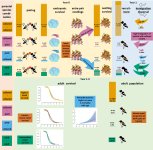Murielle Ålund, Julia Carolina Segami Marzal, Yishu Zhu, P Navaneeth Krishna Menon, William Jones, Anna Qvarnström, Tracking hybrid viability across life-stages in a natural avian contact zone,
Evolution, 2023;, qpad204,
doi.org/10.1093/evolut/qpad204 LINK
Hybrid inviability is an important post-zygotic reproductive barrier between species, but emerging signs of reduced viability can be difficult to study across the lifespan of natural hybrids. We use a combination of long-term monitoring, extra-pair paternity and mitochondrial DNA identification in a natural hybrid zone of
Ficedula flycatchers to detect emerging signs of intrinsic hybrid inviability across their entire lifespan. We evaluate possible evidence of Darwin’s corollary to Haldane’s rule, predicting asymmetries in inviability between hybrids resulting from reciprocal crosses, due to incompatible genetic factors with sex-specific inheritance patterns. We found higher hatching failure among mixed-species pairs, possibly indicating early developmental impairments associated with specific parental genetic combinations. Adult hybrids had a higher basal mortality rate than both parental species, and different age-specific mortality trajectories. There were signs of differences in age-independent mortality rates between the reciprocal hybrid crosses: hybrids with a pied flycatcher mother experienced slightly increased mortality later in life. Using an exceptional dataset with many natural hybrids tracked across life stages, we provide evidence for several emerging signs of reduced hybrid viability. Incompatibilities between alleles located on autosomes and uniparentally inherited factors such Z-linked and/or mitochondrial genes are strong candidates underlying intrinsic hybrid dysfunction in this system.







